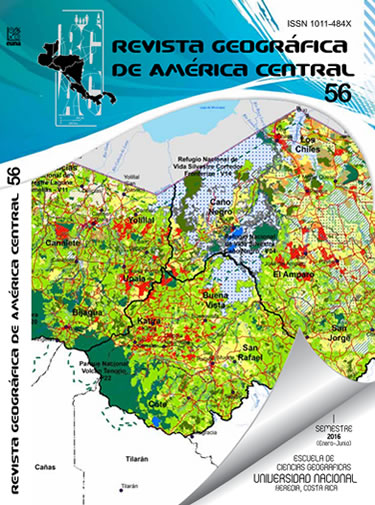GEOGRAPHICAL DIMENSION OF MSM SOCIALIZATION SPACES IN GUATEMALA CITY AND ITS RELATIONSHIP WITH TOURISM
DOI:
https://doi.org/10.15359/rgac.1-56.6Keywords:
Guatemala City, tourism, MSMAbstract
This paper examines the issue of the territorial arrangement of MSM (men who have sex with men) socialization spaces in Guatemala City and its relationship with tourism. First, we analyze some of the main concepts associated with the explanation of how such places have managed to occupy certain areas within the urban area. Then, we present an overview of Guatemala City as the central place of the country providing services to nationals and foreigners alike. The main research results are given in the last part of the paper, pinpointing at the territorial expression of the places studied. One important finding is that, regardless of its demographic volume, Guatemala City offers a limited number of homoerotic locations. These have a clearly identifiable hinterland, drawn along the southern areas of the country, and including places in neighboring countries such as El Salvador.
References
Arboleda, M. (1995) “Social attitudes and sexual variance in Lima” Latin American Male Homosexualities. University of New Mexico Press. Albuquerque, Estados Unidos. pp.100-110
Carrasco, M. (2005) ¿Comunidad homosexual? Gays y lesbianas en Santiago de Chile. Tesis de licenciatura en Psicología comunitaria. Universidad de Chile. Santiago, Chile.
Caplow, T. (1949) “The social ecology of Guatemala City”. Social Forces, 28-2. Oxford University Press. pp.113-133
Cicerone (2012) Directorio de Turismo de Centroamérica y del Caribe. Cicerone S.A. Guatemala, Guatemala.
Cifuentes, M. (2008) Expresión gráfica de la dinámica social territorial en Guatemala. Serie: El proceso de urbanización en Guatemala, 1944-2002. Centro de Estudios Urbanos y Regionales. Universidad de San Carlos de Guatemala. Guatemala, Guatemala.
Gellert, G. (1990) “Desarrollo de la estructura especial de la Ciudad de Guatemala: desde su fundación hasta la Revolución de 1944” Anuario de Estudios Centroamericanos. Universidad de Costa Rica. San José, Costa Rica. pp. 31-55
Guasch, O. (1995) La sociedad rosa. Anagrama. Barcelona, España.
Gobierno de Guatemala (2014) Salarios mínimos efectivos del 1 de enero al 31 de diciembre de 2014. Gobierno de Guatemala. Ciudad de Guatemala, Guatemala.
Laguarda, R. (2011) La calle de Amberes: gay street de la Ciudad de Mé-xico. Centro de Investigaciones Interdisciplinarias en Ciencias y Humanidades. Universidad Nacional Autónoma de México. Ciudad de México, México.
Levine, M. (1979) “Gay ghetto” Gay Men. The Sociology of Male Homosexuality. Harper and Row Publishers. Nueva York, Estados Unidos. pp. 182-204
López, A., Sánchez-Crispín, A. (2004) “Dinámica territorial del deseo queer en Monterrey, México” Ciudades, 62. Revista de la Red Nacional de Investigación Urbana. México, Distrito Federal. ISSN: 0187-8611. pp. 25-33
López, A., van Broeck A. (2013) Turismo y sexo en México. Cuerpos masculinos en venta y experiencias homoeróticas. Una perspectiva multidisciplinaria. Colección para el Siglo XXI. Instituto de Geografía, Universidad Nacional Autónoma de México. México, México.
Mancero, C. (2007). La construcción del movimiento gay y sus manifestaciones sociales, culturales y políticas en la ciudad de Quito. Tesis de maestría en Antropología Social. FLACSO. Quito, Ecuador.
Obando, M. (2003). Homosexualidad: un problema de discriminación social. Tesis de licenciatura en Trabajo Social. Universidad de San Carlos de Guatemala. Ciudad de Guatemala, Guatemala.
Propin, E. (2003). Teorías y métodos en geografía económica. Universidad Nacional Autónoma de México, Instituto de Geografía. México, México.
Sánchez-Crispín, A., López, A. (1997). “Gay-male places in Mexico City: a geographical interpretation” Queers in Space. Communities, public places and sites of residence. Bay Press. Seattle, Washington. ISBN: 0-941920-44-5. pp. 197-212
Sánchez-Crispín, A., Molliendo, G., Propin, E. (2011). “Estructura territorial del turismo en Guatemala”. Investigaciones Geográficas, 78. Instituto de Geografía, Universidad Nacional Autónoma de México. México, México.
Sánchez-Crispín, A., Propin, E. (2010). “Tipología de los núcleos turísticos primarios de América Central” Cuadernos de Turismo, 25. Universidad de Murcia. Murcia, España. pp. 165-184.
Santos, X. (2006). “Territorio e identidad: sexualidades y estrategias espaciales” Lecciones de disidencia. Infoprint. Madrid, España. pp. 45-60
Tripp, C. (1975). The homosexual matrix. A Signet Book. Nueva York, Estados Unidos.
Whitman, F. (1980). The Prehomosexual male child in three diferent socities: the United States, Guatemala and Brazil. Archives of Sexual Behaviour, 9-2. pp. 87-99.
Downloads
Published
How to Cite
Issue
Section
License
Proposed policy for journals offering Open Access
Authors publishing their works in the Journal acknowledge and agree to the following terms:
a) Authors retain the copyrights to their works and guarantee the Journal the right to be the first to publish their works, under the Creative Commons License Attribution-NonCommercial-ShareAlike 4.0 International, CC BY-NC-SA 4.0 International (https://creativecommons.org/licenses/by-nc-sa/4.0/deed.es), which allows others to share works upon complying with the acknowledgment of authorship and mention of the Journal as the original publisher of the work.
b) Authors are permitted to separately establish additional agreements for the non-exclusive distribution of the official edition of the work published in the Journal (for example, authors may desire to place the work in an institutional repository or incorporate it into a book that is to published elsewhere) so long they acknowledgment to recognize the Journal as the original publisher. The aforementioned additional agreements must respect the terms of the non-profit character and sharing philosophy of the original license (CC BY-NC-SA 4.0 International, https://creativecommons.org/licenses/by-nc-sa/4.0/deed.es).
c) Authors are encouraged to archive the post-print or editor/PDF version in Open Access repositories.






 REVGEO is licensed under https://creativecommons.org/licenses/by-nc-sa/4.0/deed.es
REVGEO is licensed under https://creativecommons.org/licenses/by-nc-sa/4.0/deed.es
.svg_4.png)

_(1).png)
_(1)_(1)_(1)_1.png)
(2)(1)(1)(1).png)
